Classic Beef Stew Recipe
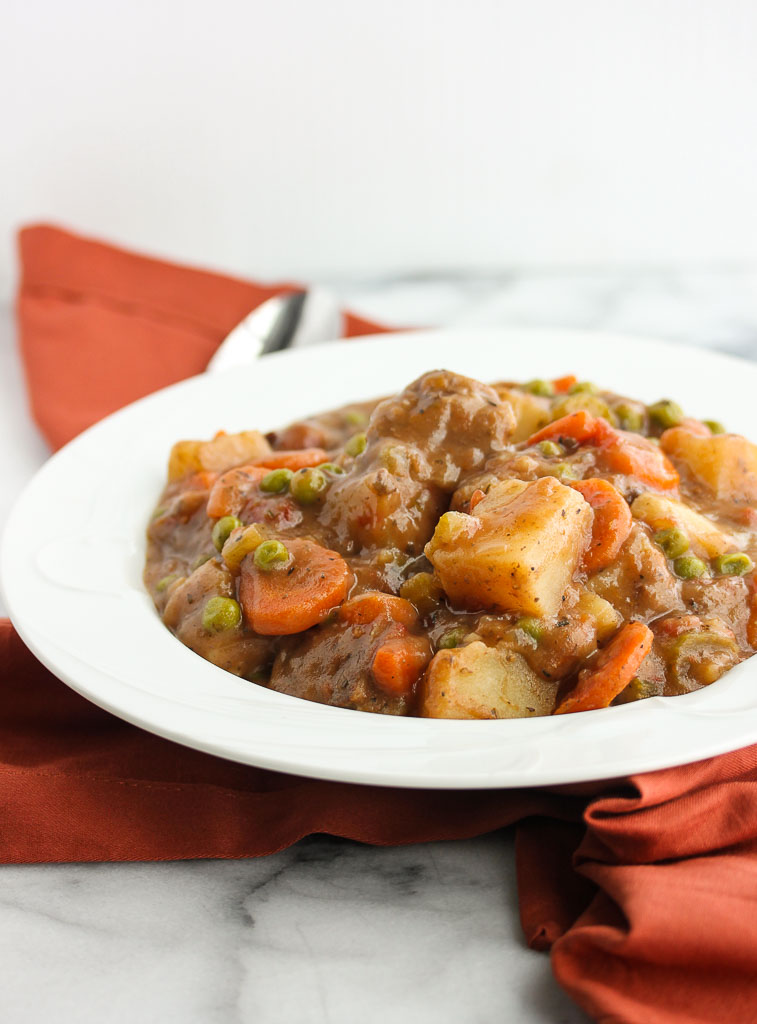
This hearty, Classic Beef Stew is full of rich savory flavor and will warm you up from the inside out on the chilliest of evenings.
A Classic Take on Beef Stew
When I think of comfort food, a hearty beef stew is right at the top of the list. Tender chunks of beef, tasty veggies, and a savory broth feel like a warm hug on a cold, winter day. Just add a side of crusty bread and you have yourself a complete meal!
Now, you have to know that I was not brought up eating amazing stew. My family’s go-to beef stew came out of a can! Super easy to make on a busy weeknight, but not quite the same as a homemade beef stew recipe.
But, I did get to experience what a good beef stew tasted like when visiting other family and friends and I was hooked. So, I set out to recreate the rich flavor of a classic beef stew.
This recipe has all the ingredients that I think of when I think of good ol’ old fashioned stew. However, if you’re looking for something a little fancier than a traditional beef stew recipe, you might want to try this Italian Beef Stew.
How to Make a Classic Beef Stew
One thing I really like about this recipe is that it’s a one-pot meal. I love one-pot meals because they typically don’t destroy your kitchen and it’s relatively easy cleanup. Both big wins in my book!
It’s hard to believe such a simple recipe can be so good. And, I know it’s good because 1.) my whole family loves it and 2.) it’s one of the more popular recipes at Lisa’s Dinnertime Dish.
As far as this being an easy beef stew recipe, it does fit that definition. There’s a bit of chopping and sautéing, but once that is done, it’s mostly just simmering while all the flavors come together.
Classic Beef Stew Ingredients
First, the beef. Once cooked, you want tender beef – not overcooked beef. So, I like to start with tougher cuts of beef that break down over the longer cooking time.
In this case, I use a round steak (see below for further explanation).
The other ingredients that I feel are essential for a classic beef stew are carrots, celery, onions, potatoes and peas. I always put the peas in right at the end so they don’t get mushy. I love that little pop in your mouth you get from them, as well as the bright green color.
How to Cook Beef Stew
Start by browning the raw beef in the bottom of the pot and then removing to a plate or small bowl. It’s a good thing if there are some browned bits in the bottom of the pan. They will just add more flavor.
Once all the beef has been browned, saute the vegetables, stir in the spices and wine and let reduce for a couple of minutes. Then, add your beef stock, tomatoes and beef and bring to a boil. Once that’s done, reduce to simmer for 1-1/2 to 2 hours, stirring occasionally.
After the simmer, add in the potatoes and simmer on low heat for another 30 minutes. Once that time is up, whisk together some beef stock and flour and add to the stew to thicken (should only take a couple if minutes).
Add in your peas and you’re ready to serve!
What is the Best Stew Meat to Use
I’m often asked what is the best beef stew meat to use in this recipe. People want to make sure they have the right cut of meat. In my opinion, the best cut of meat for a classic beef stew is a round steak.
Why round steak?
Well, firstly, it’s what I had on hand at the time I developed this recipe! Second, it’s a tougher cut of steak, so it stands up well to the long cooking time. A round steak has a lot of connective tissue and the longer cooking time allows the connective tissue to break down and dissolve into the meat (very tasty!).
Third, it tends to be really easy to find and relatively inexpensive, so another great reason to use it.
Traditionally, you’d use stew meat or chuck roast, so you certainly could use either one of those instead. They’re both excellent choices. I wouldn’t use leaner cuts of beef like tenderloin or sirloin. Since they are so lean, they will end up drying out during the long simmer. It’s much better to save those cuts for the grill!
How to Make Ahead and Store Beef Stew
Beef stew is one of those foods that always seems to get better the longer it sits, so it makes awesome leftovers. Hello, lunchtime!
You can make this a day or two ahead of time, let it sit in the fridge and then heat it up just before you want to serve it. It will be even more amazing!
So, the next time you’re looking for an awesome comfort food, look no further than this Classic Beef Stew. You’ll definitely love it as much as I do!
Tips and Tricks
- If you want to use a different cut of beef other than the round steak, stew meat or chuck roast are great substitutions.
- After browning the beef, do not put on a plate with paper towels. You want to save any juice that comes off the beef.
- Red potatoes can be substituted for the russet potatoes. Their skin is more tender than russets, so they don’t need to be peeled before adding the the stew.
- Add an extra 1 cup of beef stock if you don’t want to cook with wine. If you do want to cook with wine but don’t have any red on hand, white wine can be substituted.
- Wait until just before you serve the stew to add the peas. If you add them too soon, the peas will loose their bright color and become mushy. You want them in the stew to add a little pop of texture.
- This beef stew is freezer friendly. I would recommend dividing the leftover stew into individual portions and storing in airtight containers. This can make for an easy grab and go lunch.
Ingredients Needed to Make Classic Beef Stew
Full instructions can be found below in the printable recipe card
- Round steak – This cut of meat stands up well to low and slow cooking.
- Olive oil – I like the flavor that olive oil adds, but vegetable oil can be substituted.
- Onion – Red onion is my preference, but yellow onion would also work well in this recipe.
- Carrots – These add color flavor and texture to the stew.
- Celery – This also adds nice flavor and texture.
- Garlic – Fresh minced garlic is my preference, but 1/2 tsp garlic powder can be substituted if you don’t have fresh on hand.
- Salt – Enhances the flavor.
- Black pepper – Adds depth to the flavor.
- Herbs de provence – Italian seasoning is a good substitution if you don’t have this herb blend on hand.
- Red wine – The wine adds some complexity to the flavor.
- Beef stock – Helps to make the sauce extra flavorful.
- Canned diced tomatoes
- Flour – This is the thickening agent for the stew.
- Russet potatoes – The starch from the potatoes also helps to thicken the stew as well as adding nice texture and flavor.
- Frozen peas – These are added both for color and texture.
How to Make Classic Beef Stew
- Heat olive oil in a large pot over high heat.
- Add beef in batches, careful not to overcrowd the pan.
- Brown beef 2 minutes per side.
- Remove from pan and set aside on a plate or small bowl.
- Reduce to medium heat and add a little more olive oil, if necessary.
- Saute onion, carrots, celery and garlic for about 5 minutes, until onions are translucent.
- Stir in 1/2 tsp salt, 1/2 tsp pepper and herbes de provence.
- Stir in wine, bring to a bubble and let reduce for a couple of minutes.
- Stir in 2 cups beef stock, tomatoes and beef, bring to a boil.
- Reduce heat to simmer, cover and simmer for 1 1/2 – 2 hours, stirring occasionally.
- After stew has simmered, add potatoes, remaining 1 tsp salt and remaining 1/2 tsp pepper. Continue simmering for another 30 minutes.
- Whisk together remaining 1/2 cup beef stock and flour, stir into stew.
- Continue cooking until stew has thickened, this should only take a couple of minutes.
- Stir in peas and serve.
More Stews to Enjoy
- Italian Beef Stew
- Sweet Potato Mushroom Beef Stew
- Easy Weeknight Winter Stew
- Beef Bourguignon
- Country Chicken Stew
- Korean Beef Stew
- Taco Stew
- Easy Hobo Stew
Classic Beef Stew Recipe
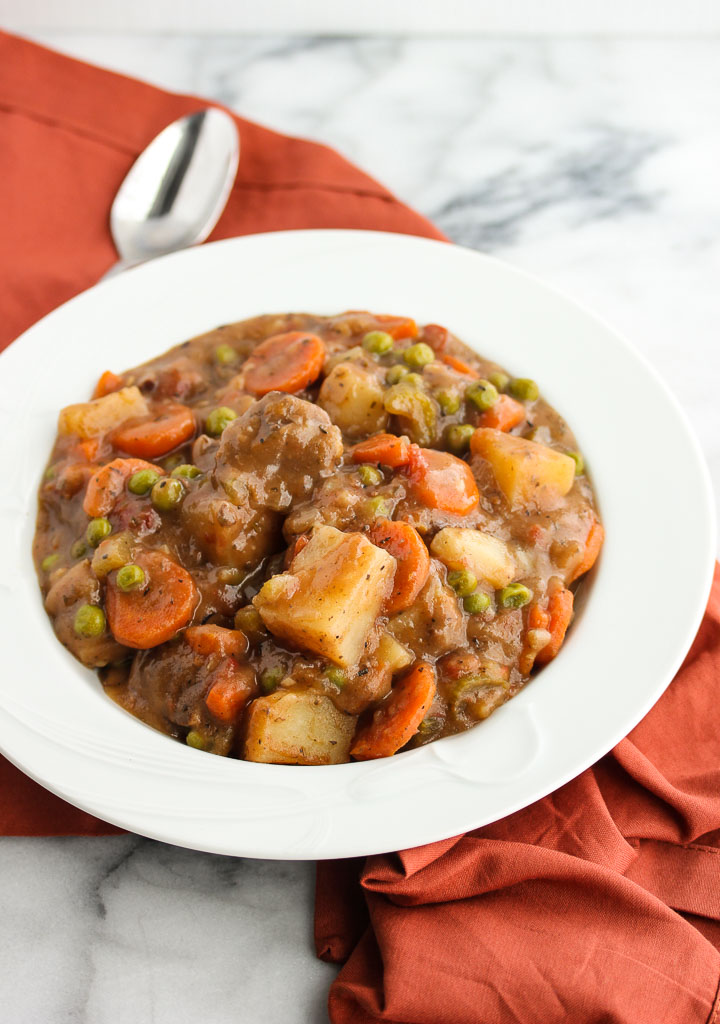
This hearty, Classic Beef Stew is full of rich savory flavor and will warm you up from the inside out on the chilliest of evenings.
Ingredients
- 1 ½ lbs round steak cut into chunks
- 2 tbsp olive oil
- 1 medium onion, chopped
- 2 large carrots, sliced
- 2 large stalks celery, sliced
- 3 cloves garlic, minced
- 1 ½ tsp salt, divided
- 1 tsp pepper, divided
- 1 tbsp herbs de provence
- 1 cup red wine
- 2 ½ cups beef stock, divided
- 1 (15oz) can diced tomatoes
- ¼ cup flour
- 2 medium russet potatoes peeled and diced
- 1 cup frozen peas, thawed
Instructions
- Heat olive oil in a large pot over high heat.
- Add beef in batches, careful not to overcrowd the pan.
- Brown beef 2 minutes per side.
- Remove from pan and set aside on a plate or small bowl.
- Reduce heat to medium and add a little more olive oil, if necessary.
- Saute onion, carrots, celery and garlic for about 5 minutes, until onions are translucent.
- Stir in ½ tsp salt, ½ tsp pepper and herbes de provence.
- Stir in wine, bring to a bubble and let reduce for a couple of minutes.
- Stir in 2 cups beef stock, tomatoes and beef, bring to a boil.
- Reduce heat to simmer, cover and simmer for 1 ½ - 2 hours, stirring occasionally.
- After stew has simmered, add potatoes, remaining 1 tsp salt and remaining ½ tsp pepper. Continue simmering for another 30 minutes.
- Whisk together remaining ½ cup beef stock and flour, stir into stew.
- Continue cooking until stew has thickened, this should only take a couple of minutes.
- Stir in peas and serve.
Notes
- Stew meat or chuck roast are also good cuts of meat to use in this recipe.
Nutrition Information:
Yield:
6Serving Size:
1Amount Per Serving: Calories: 439Total Fat: 15gSaturated Fat: 5gTrans Fat: 0gUnsaturated Fat: 9gCholesterol: 102mgSodium: 918mgCarbohydrates: 28gFiber: 5gSugar: 5gProtein: 41g
ENJOY!


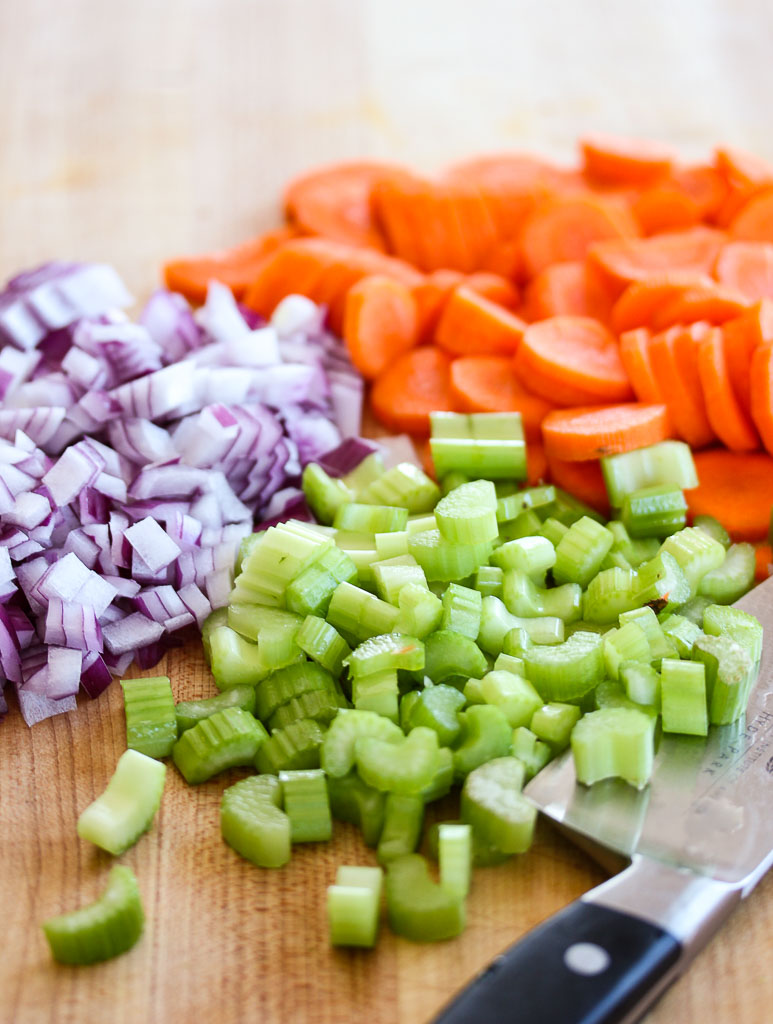
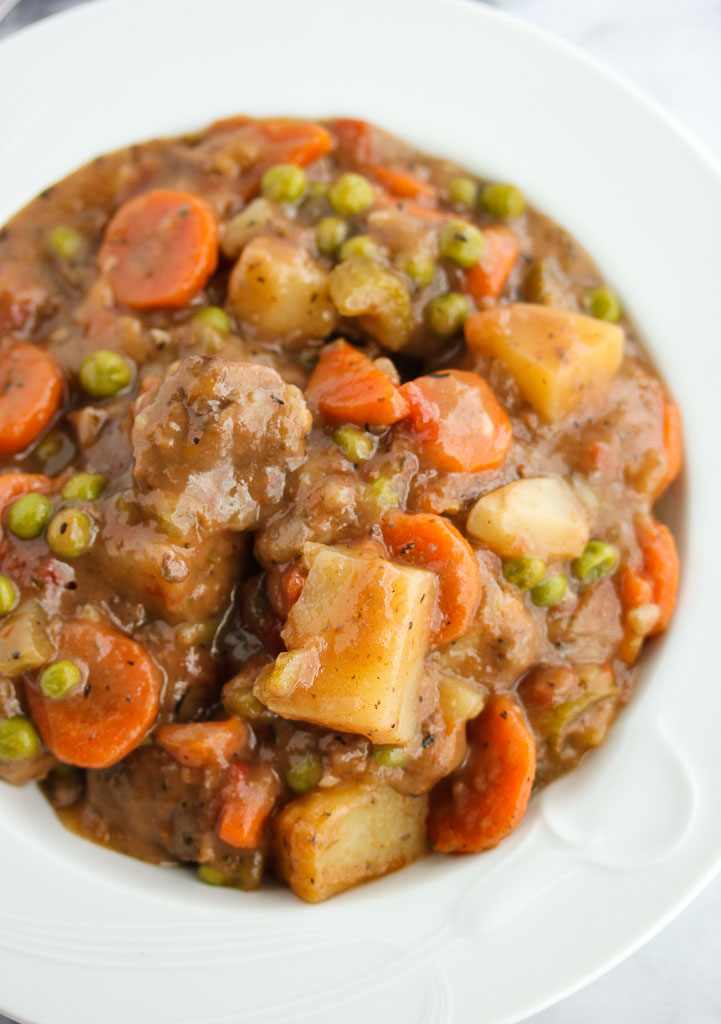
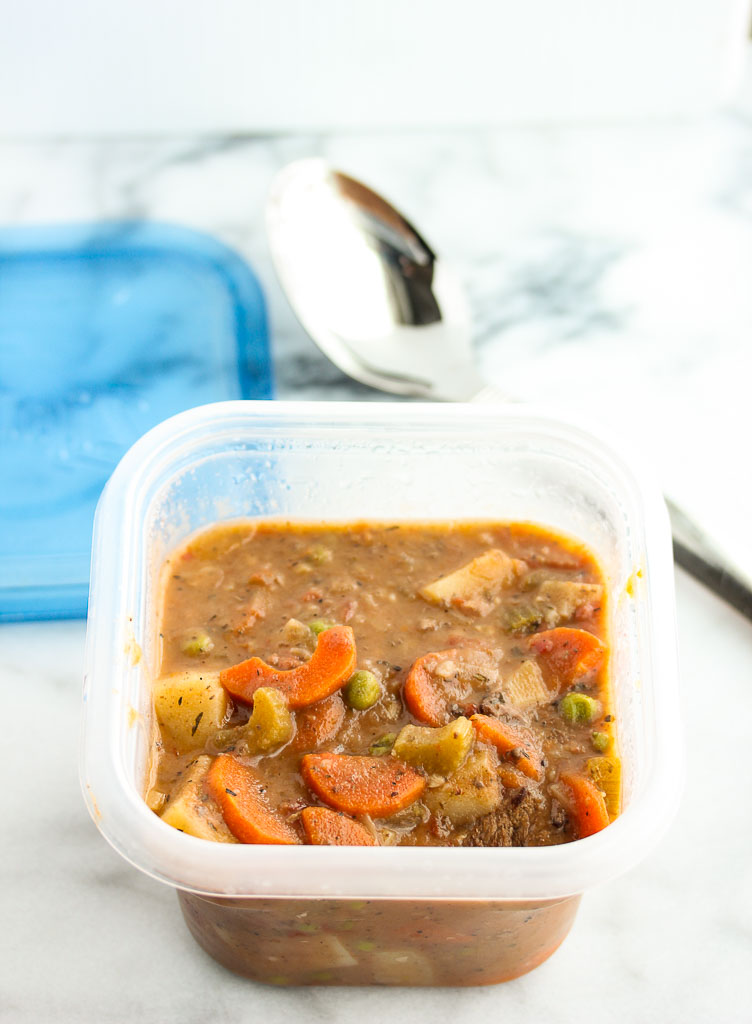

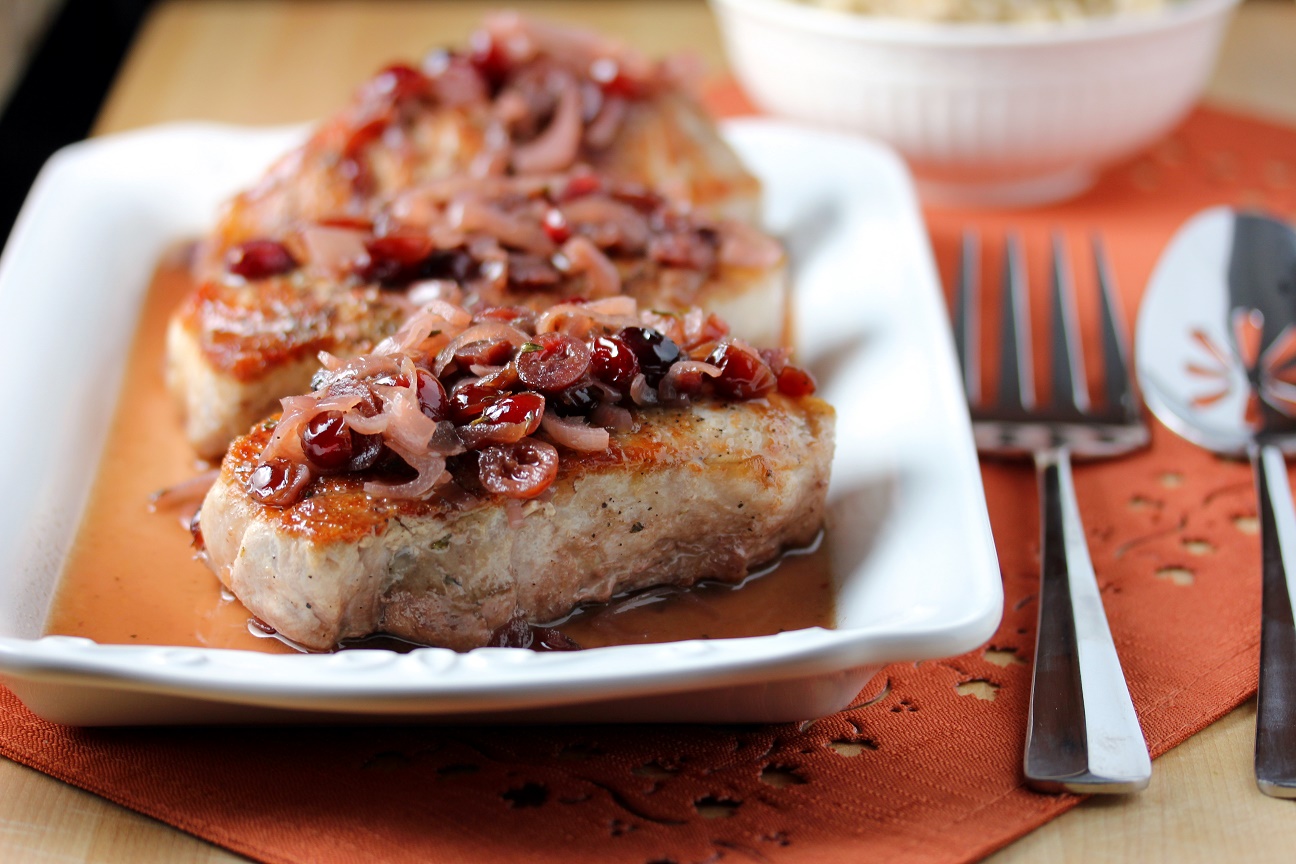
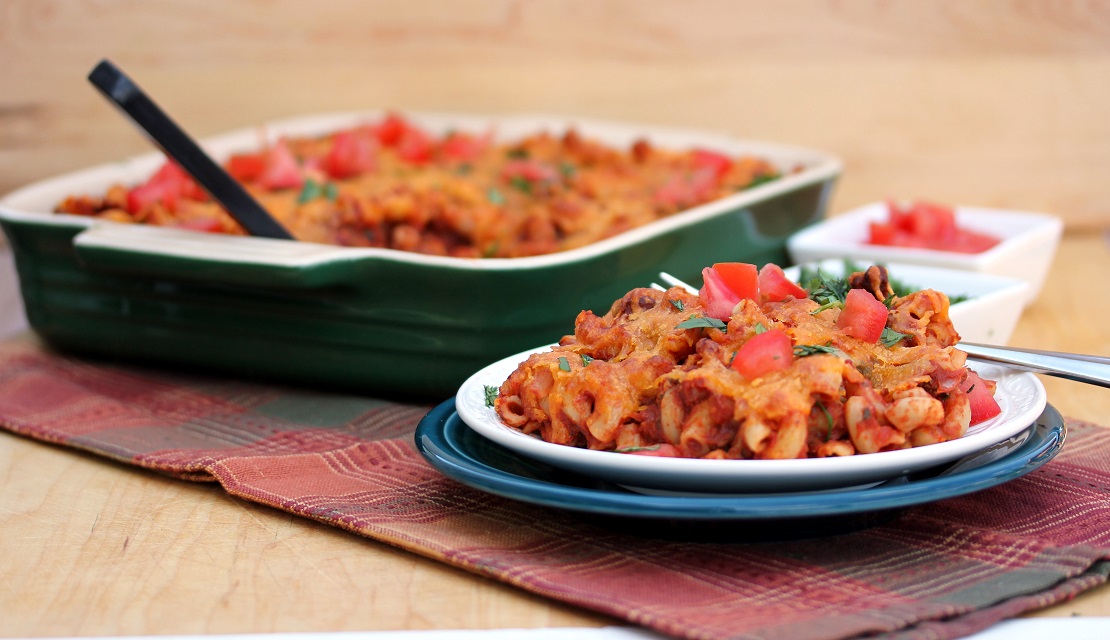



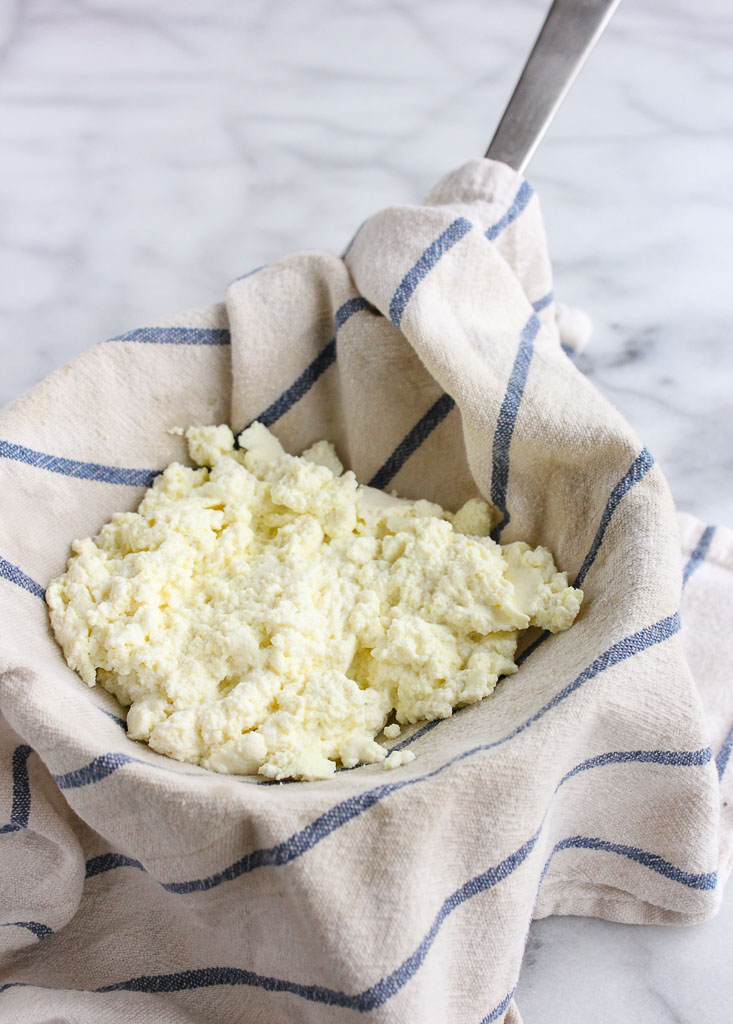
DEEEEE-Lish! Looks mouth-watering. All your photos are super great. Thanks for sharing with us at Weekend Potluck. Keep em comin…please.
THANK YOU FOR SHARING. CAN’T IMAGINE LIVING WHERE IT IS THAT COLD. IT WILL BE IN THE 70’S HERE WHERE I LIVE IN LOUISIANA TODAY 1-30-2016
70’s would feel great right now, Donnie! Thanks for stopping by!
Hello
Your instructions don’t say when to add the beef back into the stew. There’s no place saying where to add it back in after you brown it.
I’m making it now!
(*_*)
Chelle
Sorry about that Michelle! You add the beef back in at the same time you add the stock and the tomatoes. I hope your enjoy it as much as we did!
When I make a beef stew I use round steak as well. I cook it first as a roast with stew bones for some extra juice and flavour. Your version of beef stew sounds delicious and I can’t wait to try it!
What kind of red wine do you use in this recipe. I have never cooked with wine probably because I don’t know if it is a cooking wine or regular drinking wine and what makes the difference if using red or white wine. This recipe sounds wonderful.
Thanks, Jan! I used a cabernet sauvignon in this recipe, but merlot or pinot noir would also work. You just want to make sure you use a dry red wine and not something sweet. I would definitely use a drinking wine as opposed to a cooking wine. You want to use something that would actually taste good on its own. I hope this helps!
Lisa
what exactly is herbs de provence?
Hi Grace,
It’s a dried spice blend. You should be able to find it in the spice aisle at the regular grocery store.
Lisa
I just love soups and stews and it’s perfect for these cold days! This stew looks so creamy and delicious!
I haven’t made beef stew in a long time. Your recipe looks great – all those veggies in there. Nice recipe.
This is one of my favorite cool weather meals! Your recipe sounds AMAZING!!
Thanks for this simple and yet timeless bowl of warm comfort. I wish I had some of in front of me right now!
Leftover stew is even better the next day in my opinion! Stew is such a delicious belly warming meal!
This looks perfect!! I love a good beef stew!
Nothing is more comforting on a chilly day than a bowl of gorgeous stew!
A hearty stew is always a great idea for a fall dinner!
I want this for dinner! I love beef stew!
I always say, it doesn’t have to be fancy to be fabulous, and this is definitely fabulous! Love the chunks of veggies… This is the perfect beef stew!!!
Looks like the perfect comfort food dish for when the weather turns really cold! I’m bookmarking this one!
Hi, I was wondering if this could be made in the slow or or maybe an instant pot
Stew meat is not a kind of beef. In fact whatever is labeled as stew meat in the supermarket could be anything – whatever scrap was left over. Chuck is always going to be a better choice for stew and round because it’s gonna be more tender because it has more connective tissue
@Jim, Thanks JIM, can you tell me why Eye of round roast is always so tough !!!!I cook in a crock pot at the right temp. and not over cook but always comes out “TUFF” . Thanks, dee